

|
| DEUTSCHLAND | GERMANY |
| Bundesland: Baden-Württemberg | |
| Regierungsbezirk: Tübingen | |
| Stadt: Ulm |
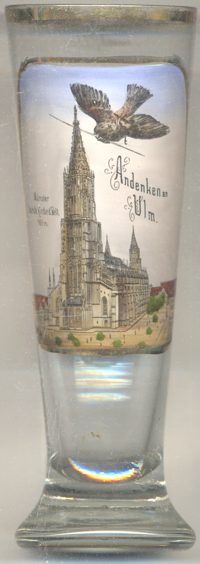 Ulm is situated et the left bank of the river Danube at the border between the German states of Baden-Württemberg and Bavaria.
The first mention of Ulm in a document dates from AD 854 and refers to it as a Karolingian residence. Around 1165 it was granted the status
of a town by Emperor Friedrich I Barbarossa. In 1274 it was elevated to a Free Imperial City. During the Middle Ages Ulm became a wealthy
trading town. The town's constitution ('Großer Schwörbrief') of 1397 ended vigourous clashes between the town's classes. Ulm's political
importance peaked in the 14th century when it headed the federation of Swabian cities. Its economic importance peaked towards the end of that century.
After a referendum in 1530 the citizens converted to the protestant faith. In 1802 Ulm lost its status as a Free Imperial City and came into possession of Bavaria.
From 1810 on it belonged to Württemberg. After the Napoleonic Wars Ulm became an important garrison place and received one of the largest fortresses (built 1842–1849)
in Europe. After 1900 the fortress lost its military significance. During World War II the city suffered severe damages, 85% of the old town were destroyed.
The industrial development of the following years secured Ulm's economic position in the 20th century. The university of Ulm was opened in 1960.
Ulm is situated et the left bank of the river Danube at the border between the German states of Baden-Württemberg and Bavaria.
The first mention of Ulm in a document dates from AD 854 and refers to it as a Karolingian residence. Around 1165 it was granted the status
of a town by Emperor Friedrich I Barbarossa. In 1274 it was elevated to a Free Imperial City. During the Middle Ages Ulm became a wealthy
trading town. The town's constitution ('Großer Schwörbrief') of 1397 ended vigourous clashes between the town's classes. Ulm's political
importance peaked in the 14th century when it headed the federation of Swabian cities. Its economic importance peaked towards the end of that century.
After a referendum in 1530 the citizens converted to the protestant faith. In 1802 Ulm lost its status as a Free Imperial City and came into possession of Bavaria.
From 1810 on it belonged to Württemberg. After the Napoleonic Wars Ulm became an important garrison place and received one of the largest fortresses (built 1842–1849)
in Europe. After 1900 the fortress lost its military significance. During World War II the city suffered severe damages, 85% of the old town were destroyed.
The industrial development of the following years secured Ulm's economic position in the 20th century. The university of Ulm was opened in 1960.
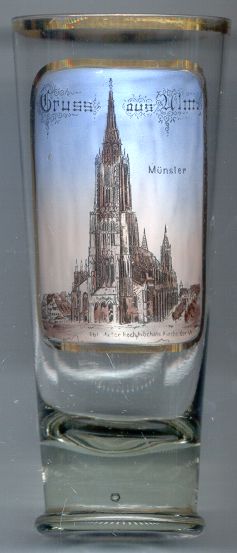
The  Ulmer Münster (minster church) [left, no. 1346; and right, no. 3299]
was built after plans of the Parler architect family (Heinrich II, Michael, Heinrich III) starting in 1377.
The chancel was consecrated in 1383. After 1392 the construction works were headed by Ulrich Ensinger who also made the first plans for the
mighty west tower. Matthias Böblinger began the construction of the tower in 1474. At the end of the 16th century the works stopped and left the tower unfinished.
It was not until 1844 that the construction was resumed after the original plans of Matthias Böblinger. The tower, finished in 1890 by August Beyer, was the world's
highest church tower (161.5 m) until 2025 when it was surpassed by the main tower of the basilica La Sagrada Familia in Barcelona.
Glass no. 3299 [right] is also labeled “Münster /
höchste Kirche d[er] Welt, / 161 m” (minster church / the world's tallest church).
Ulmer Münster (minster church) [left, no. 1346; and right, no. 3299]
was built after plans of the Parler architect family (Heinrich II, Michael, Heinrich III) starting in 1377.
The chancel was consecrated in 1383. After 1392 the construction works were headed by Ulrich Ensinger who also made the first plans for the
mighty west tower. Matthias Böblinger began the construction of the tower in 1474. At the end of the 16th century the works stopped and left the tower unfinished.
It was not until 1844 that the construction was resumed after the original plans of Matthias Böblinger. The tower, finished in 1890 by August Beyer, was the world's
highest church tower (161.5 m) until 2025 when it was surpassed by the main tower of the basilica La Sagrada Familia in Barcelona.
Glass no. 3299 [right] is also labeled “Münster /
höchste Kirche d[er] Welt, / 161 m” (minster church / the world's tallest church).
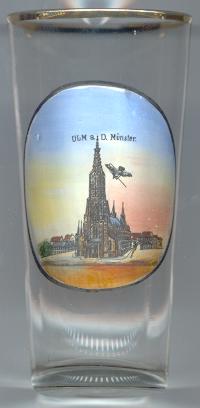 The picture on glasses no. 3299 [far right] and no. 960 [near right] also shows a beloved symbol of Ulm, the Ulmer Spatz
(Sparrow of Ulm). According to a popular tale the citizens of Ulm faced a problem that seemed unsolvable to them. They needed long logs for the construction of the church roof.
But, as they had placed the logs transversally on their carts, they could not pass through the town's gate. Then, one of the citizens observed that a little
sparrow, which had built its nest in a hole of the town wall, came home to the nest carrying a twig in its beak. The bird pulled the twig
through the hole in a longitudinal manner and thus taught the citizens how to bring their logs into the town. Of course, this means that the citizens of Ulm
could not have been very bright. Even today the people of Ulm are sometimes teased by calling them 'sparrows'.
Nevertheless, Ulm has become very fond of this story and the figure of the sparrow is present all around the city.
The picture on glasses no. 3299 [far right] and no. 960 [near right] also shows a beloved symbol of Ulm, the Ulmer Spatz
(Sparrow of Ulm). According to a popular tale the citizens of Ulm faced a problem that seemed unsolvable to them. They needed long logs for the construction of the church roof.
But, as they had placed the logs transversally on their carts, they could not pass through the town's gate. Then, one of the citizens observed that a little
sparrow, which had built its nest in a hole of the town wall, came home to the nest carrying a twig in its beak. The bird pulled the twig
through the hole in a longitudinal manner and thus taught the citizens how to bring their logs into the town. Of course, this means that the citizens of Ulm
could not have been very bright. Even today the people of Ulm are sometimes teased by calling them 'sparrows'.
Nevertheless, Ulm has become very fond of this story and the figure of the sparrow is present all around the city.
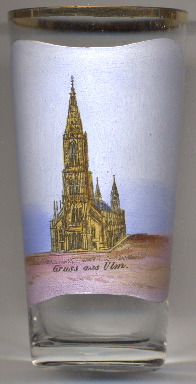
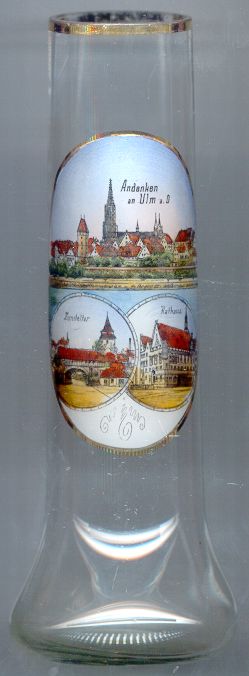
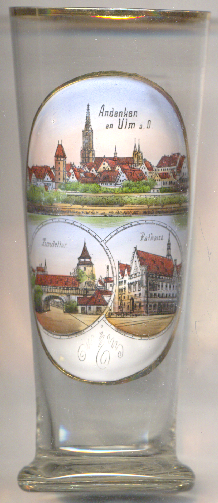
The tower depicted in the top picture of glass no. 1637 [left] and no. 4758 [right] to the left of the minster church is the
 Metzgerturm
Metzgerturm
The  Zundeltor [bottom left picture] gate was created only in 1870. It received its name
from the gunpowder and tinder (German: Zunder) which were stored in the adjacent tower (built in the 14th century).
Zundeltor [bottom left picture] gate was created only in 1870. It received its name
from the gunpowder and tinder (German: Zunder) which were stored in the adjacent tower (built in the 14th century).
The  Rathaus (Town Hall) [bottom right] is a complex of three buildings dating
back to 1657. Originally they served as a warehouse (mentioned in 1363) and as a place of justice (mentioned 1382).
At least since 1395 it seemed to have been the seat of the city council. In 1419 it was first mentioned as "Rathaus" (town hall).
After 1592 the complex was rebuilt. Further extended renovations were carried out around 1900.
In December 1944 the town hall was damaged severely by fire. After the war the town hall was rebuilt according to its original
appearance.
The frescos on the northern and eastern façades were created around 1540.
The astronomical clock with 14 functions dates from 1520. A sun dial was added in 1540, a time-piece was added in 1553.
The clock was then renewed in 1580. In 1944 the mechanics was destroyed but was rebuilt in 1952.
Rathaus (Town Hall) [bottom right] is a complex of three buildings dating
back to 1657. Originally they served as a warehouse (mentioned in 1363) and as a place of justice (mentioned 1382).
At least since 1395 it seemed to have been the seat of the city council. In 1419 it was first mentioned as "Rathaus" (town hall).
After 1592 the complex was rebuilt. Further extended renovations were carried out around 1900.
In December 1944 the town hall was damaged severely by fire. After the war the town hall was rebuilt according to its original
appearance.
The frescos on the northern and eastern façades were created around 1540.
The astronomical clock with 14 functions dates from 1520. A sun dial was added in 1540, a time-piece was added in 1553.
The clock was then renewed in 1580. In 1944 the mechanics was destroyed but was rebuilt in 1952.
![[scale]](lineal.jpg)